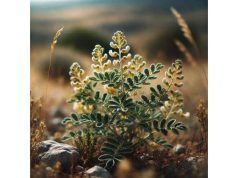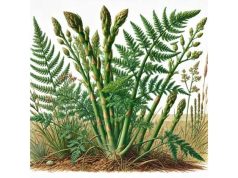
Agastache is a captivating genus of aromatic and ornamental herbs in the mint family (Lamiaceae), commonly revered for their vibrant flower spikes, distinct licorice or anise-like fragrance, and versatile culinary and medicinal potential. Native predominantly to North America and East Asia, these perennials have found a cherished place in gardens, herbal medicine cabinets, and kitchen spice racks worldwide. Often called “giant hyssop,” “anise hyssop,” or “hummingbird mint,” Agastache species boast showy blooms in shades of purple, pink, orange, and red, making them a magnet for pollinators. Meanwhile, the leaves’ sweet and minty undertones have historically inspired numerous uses, ranging from herbal infusions to flavoring for sweet treats.
Across indigenous cultures and traditional herbal practices, Agastache has been embraced for its potential to soothe digestion, calm nerves, and even reduce fevers. Modern horticulturists and herbalists likewise appreciate the plant’s culinary adaptability and pollinator-friendly nature. As research into its phytochemical composition deepens, interest grows in its essential oils and compounds, suggesting a range of beneficial properties that may support the immune system, ease mild inflammation, and provide natural antibacterial or antifungal actions. The distinct flavors, charming aesthetics, and emerging studies have secured Agastache an enduring role in herb gardens, holistic wellness circles, and ecological landscape designs.
Key highlights of Agastache include:
- Distinct anise or licorice-like scent that adds flavor complexity to teas and recipes
- Vibrant flower spikes that attract hummingbirds, bees, and butterflies
- Potential digestive support, respiratory relief, and calming effects in traditional medicine
- Rich in essential oils with possible antibacterial and antifungal properties
- Easy to grow, drought-tolerant, and suitable for pollinator-friendly gardening
Table of Contents
- Agastache: Botanical Features and Notable Traits
- Agastache: Historical Context and Cultural Significance
- Agastache: Active Constituents and Phytochemical Profile
- Agastache: Key Health Benefits and Core Properties
- Agastache: Diverse Applications and Important Safety Notes
- Agastache: Significant Studies and Recent Findings
- Agastache: Frequently Asked Questions
Agastache: Botanical Features and Notable Traits
Taxonomy and Varieties
Agastache is part of the mint family, Lamiaceae, which includes popular herbs such as basil, rosemary, and lavender. The genus name Agastache is derived from Greek, combining “agan,” meaning “very much,” and “stachys,” meaning “spike,” referencing the plant’s abundant floral spikes. This genus comprises about 22 recognized species, with some of the most popular including:
- Agastache foeniculum (Anise Hyssop)
Characterized by purple flower spikes and an unmistakable anise aroma. - Agastache rugosa (Korean Mint)
A staple in East Asian herbal medicine, also known for its purple blooms but with a slightly different fragrance profile. - Agastache mexicana (Mexican Giant Hyssop)
Favored in Mexican cuisines, with pink or purple flower spikes and a lemony-mint essence. - Agastache aurantiaca (Orange Hummingbird Mint)
Noted for bright orange or salmon-colored flowers and a more citrus-like fragrance, heavily used in ornamental gardens.
Native Habitats and Global Spread
Agastache species are primarily distributed in:
- North America: Many species, such as Anise Hyssop, are native to the central and northern regions, thriving in prairies, open woodlands, and grasslands.
- East Asia: Korean Mint is found in China, Korea, and parts of Japan, particularly in temperate lowlands and mountainsides.
- Cultivation Worldwide: Thanks to ornamental appeal and herbal interest, gardeners globally cultivate Agastache. Hybrid forms appear in European, Australian, and South American gardens.
Physical Description
- Height and Structure:
- Depending on the species, Agastache can grow 60–150 cm (2–5 ft) tall.
- They generally have upright, branching stems with square cross-sections—typical of many mint family plants.
- Leaves:
- Oppositely arranged, often heart-shaped or ovate with serrated edges.
- Most species exude a fragrant aroma upon crushing, reminiscent of anise, mint, licorice, or citrus.
- Flowers and Flower Spikes:
- Clusters of tubular blooms form elongated spikes at the tops of stems.
- Colors vary from pastel lavender and pink to electric orange and bright red. The bright floral spikes typically attract hummingbirds, butterflies, and bees.
- Seeds and Reproduction:
- Seed heads form after flowering, containing tiny nutlets or seeds.
- Propagation is possible by seed, cuttings, or division. Many species self-seed easily under suitable conditions.
Growing Requirements and Maintenance
- Soil Preference: Well-draining, loamy soil is ideal. Agastache tolerates sandy or rocky soils but may struggle in waterlogged conditions.
- Sun Exposure: Prefers full sun for optimal flowering and growth. Partial shade can be acceptable for some varieties, though the plant typically blooms more profusely with abundant sunlight.
- Watering: While relatively drought-tolerant once established, consistent watering in the early growth stage fosters robust root development. Overwatering can cause root rot in heavier soils.
- Fertilizing: Often minimal feeding is required. Over-fertilization can lead to leggy growth and reduced aromatic oil concentration in leaves.
- Pruning and Deadheading: Removing spent blooms prolongs flowering, prevents excessive self-seeding, and keeps the plant tidy.
Ecological Significance
- Pollinator Magnet: The brightly colored, tubular flowers are beloved by bees, butterflies, and hummingbirds seeking nectar.
- Biodiversity Support: In garden ecosystems, Agastache aids in sustaining beneficial insects, thus contributing to natural pest control.
- Companion Planting: Placing Agastache near crops or flowers that benefit from pollinators can enhance overall yield and garden health.
In summary, the distinct licorice scent, ornamental spikes, and ease of growth define Agastache as a multitasking gem among perennial herbs. Whether you’re seeking vibrant color in your flowerbeds or an aromatic herb for teas and culinary experiments, its adaptability and low-maintenance nature make it a garden staple. The next sections delve into its storied past, impressive chemical constituents, and recognized health benefits.
Agastache: Historical Context and Cultural Significance
Early Indigenous and Traditional Uses
Several Agastache species trace back centuries of usage among Native American tribes and East Asian communities:
- North American Native Tribes:
- Tribes like the Lakota, Cheyenne, and Navajo recognized Anise Hyssop (Agastache foeniculum) for its medicinal properties—employing infusions to support digestion, manage coughs, and treat colds.
- Leaves also occasionally appeared in sweat lodge rituals, harnessing their aromatic steam.
- East Asia:
- In Traditional Chinese Medicine (TCM), Korean Mint (Agastache rugosa), known as “Huoxiang,” forms part of formulas addressing dampness-related conditions, gastrointestinal disorders, and to promote overall qi balance.
- It’s believed to have “aromatic damp-dispelling” qualities, used to reduce bloating, nausea, and mild fevers.
Influence on Culinary Traditions
- Flavoring Agent: Several species, especially Anise Hyssop, were historically used to flavor teas, breads, and sweet dishes. The leaves’ sweet aftertaste lent itself to herbal candies and honey infusions.
- Seasonal Celebrations: Some communities integrated Agastache into festive meals or ceremonies, recognizing its calming qualities.
- Preservation of Food: Although less documented, the plant’s pungent aroma may have helped in mild preservation or odor masking for stored foods.
Evolution of Ornamental Popularity
With the rise of horticulture in the 19th and 20th centuries, species like Agastache foeniculum and Agastache mexicana found fame in ornamental gardens:
- Victorian Gardens: Anise Hyssop occasionally featured in English cottage gardens for both form and function—attracting bees for honey production while doubling as an aromatic herb.
- Modern Hybrid Cultivars: Breeders developed new cultivars with enhanced color vibrancy and extended bloom times, fueling renewed interest in pollinator gardens, especially in the United States and Europe.
Present-Day Integration and Revival
- Farmers’ Markets and Herbal Education: As local food movements gain traction, fresh or dried Agastache leaves appear in specialty herb stands. Herbalists hold workshops exploring the plant’s uses in teas, salves, and flavor extracts.
- Commercial Teas and Products: Some small-scale producers offer Agastache-based blends, marketing them as calming or digestive-friendly beverages. Essential oils from certain species are also made into artisanal lotions or aromatic blends.
Cultural Highlights and Symbolism
- Folklore and Symbolic Meanings: In some narratives, Anise Hyssop symbolizes protection, longevity, or renewal. Others see it as a bridging herb between the spiritual and physical realms due to its powerful fragrance.
- Literary Mentions: While not as ubiquitous as rosemary or thyme, references to licorice mint or hyssop occasionally appear in diaries and herbal treatises from early American settlers, praising its sweet flavor and beneficial essence.
From indigenous medicinal traditions to contemporary horticultural star, Agastache’s cultural journey is marked by versatility and consistent appreciation. This bridging of old and new underscores the herb’s enduring relevance—whether healing a cough, delighting hummingbirds, or gracing an herbal tea blend. Coming up next, we’ll explore the chemical cornerstones that empower these uses.
Agastache: Active Constituents and Phytochemical Profile
Behind Agastache’s distinctive scent and noted health potential are complex arrays of phytochemicals. These compounds contribute to the plant’s aroma, flavor, and various reported therapeutic actions.
Essential Oils
- Estragole (Methyl Chavicol):
- A major volatile in species like Anise Hyssop (Agastache foeniculum) and Korean Mint (Agastache rugosa).
- Responsible for the sweet, licorice-like aroma. While some concerns exist regarding estragole’s safety at high concentrations, typical culinary usage is generally considered safe for most healthy adults.
- Limonene, Linalool, and Citronellol:
- Contribute subtle floral, citrus, or minty notes.
- Known for mild antimicrobial and calming properties, commonly found in many aromatic herbs.
- Menthone and Menthol (in certain cultivars):
- Impart a cool, minty sensation to leaves or flower bracts.
- May exhibit analgesic or anti-inflammatory benefits in topical applications.
Polyphenols and Flavonoids
- Rosmarinic Acid:
- Common in the Lamiaceae family (including rosemary and sage). Shows strong antioxidant and anti-inflammatory activity in lab studies.
- Quercetin, Rutin, and Other Flavonoids:
- Act as free-radical scavengers, supporting overall cellular health.
- Potential synergy with essential oils can enhance antimicrobial and immunomodulatory properties.
Tannins
Some Agastache species contain moderate levels of tannins, which:
- Aid in Digestive Astringency: Minimizing mild diarrhea or offering a protective effect on the gut lining.
- Enhance Preservation: Historically, the astringent nature might have helped in minor food preservation or drying processes.
Other Minor Components
- Coumarins: Traces can offer mild vasodilatory or anti-inflammatory effects, though further study is required for conclusive insights.
- Minerals and Nutrients: While not a major nutritional powerhouse, leaves do provide small quantities of vitamins and trace minerals, including potassium, calcium, and iron.
Variation and Environmental Factors
The concentration of these compounds is not static. It varies depending on:
- Species and Cultivar: Different Agastache lines boast distinct aromatic profiles—some heavier on anise notes, others featuring more citrus or mint.
- Climate and Soil: Warmer, sunnier conditions can elevate essential oil production, while poor, sandy soils tend to produce more intensely flavored leaves compared to rich, moist ground.
- Harvest Time: Gathering leaves and flowers during peak bloom, often mid-morning after dew dries, ensures the highest essential oil content.
Synergistic Action
Many herbal experts posit that the synergy of multiple compounds in Agastache is what confers its mild yet noticeable benefits:
- Bittersweet Flavor Compounds + Essential Oils: Create a relaxing, soothing infusion that can calm the stomach and support respiratory function.
- Polyphenols + Volatiles: May generate a broad range of antimicrobial or antiviral effects, albeit mild.
- Combining with Other Herbs: Pairing Agastache with lemon balm, licorice root, or ginger can augment complementary effects and improve taste complexity.
Understanding the interplay of these constituents clarifies why Agastache stands out as both an ornamental and functional herb. Its chemical tapestry shapes each species’ sensory profile and underlies the wide array of possible uses.
Agastache: Key Health Benefits and Core Properties
While modern research on Agastache remains relatively modest compared to more mainstream herbs, centuries of anecdotal evidence and limited emerging studies reveal some consistent themes regarding its potential advantages.
1. Digestive Support
- Appetite Stimulation: Agastache’s sweet, licorice-like taste can gently enhance appetite. This effect proves beneficial for individuals recovering from illnesses or dealing with reduced hunger.
- Gas and Bloating Relief: Many species exhibit carminative properties, which help expel gas and reduce bloating or abdominal discomfort.
- Soothing Upset Stomachs: The combination of volatile oils and mild tannins can calm minor digestive disturbances, sometimes used in herb tea blends for mild nausea or indigestion.
2. Respiratory Comfort and Cold Relief
- Traditional Use: Native American and Asian communities have used Agastache teas or steams for easing coughs or mild chest congestion.
- Possible Decongestant Action: The aromatic constituents, particularly estragole and linalool, may help loosen mucus and open airways. Sipping warm Agastache infusions can alleviate mild cold symptoms.
- Calming Menthol Notes (in some cultivars): Provide an additional sense of refreshment, potentially beneficial for irritated throats.
3. Antimicrobial and Antifungal Effects
- Essential Oil Efficacy: Laboratory tests suggest that concentrated extracts from certain Agastache species can inhibit bacterial and fungal growth, including strains of Candida.
- Surface Cleanser or Mild Disinfectant: Some herbalists recommend diluted Agastache infusions to cleanse minor cuts, though robust evidence is sparse.
4. Stress Relief and Mood Support
- Calming Aroma: The sweet anise fragrance can have a gentle relaxing effect on the central nervous system, reminiscent of how lavender or chamomile promotes calm.
- Potential Anxiety Reduction: Historically, some cultures brewed Agastache to relieve mild nervous tension or irritability. While not a strong sedative, the herb’s mild anxiolytic property can complement other stress-management strategies.
5. Anti-Inflammatory and Antioxidant Action
- Polyphenols and Flavonoids: The presence of rosmarinic acid, quercetin, and other antioxidants suggests that Agastache may help reduce oxidative stress and low-grade inflammation.
- Protective Potential: While more human trials are necessary, preliminary in vitro data indicate that these constituents can protect cells from damage, possibly supporting cardiovascular or joint health over time.
6. Heart and Circulatory System
- Historically Speculated: In some folk remedies, mild diuretic or circulatory benefits were attributed to the herb, though scientific backing is still limited.
- Possible Blood Pressure Support: If the herb’s mild vasodilatory effects apply in clinical settings, it may modestly aid those with borderline hypertension, but professional advice is needed.
7. Skin Applications
- Topical Preparations: Some herbal formulas incorporate Agastache essential oil or steeped water in creams or lotions for gentle antibacterial or anti-inflammatory effects.
- Soothing Minor Irritations: A cooled Agastache tea compress can calm mild rashes or bug bites.
Balancing Perspective and Precautions
- Mild Herb, Subtle Effects: Agastache is not generally considered a potent curative for severe ailments. Instead, it provides supportive, gentle relief for mild conditions.
- Complement, Not Substitute: Those dealing with chronic or significant health concerns should consult healthcare providers before relying on herbal solutions.
- Individual Variation: Sensitivity to estragole or allergic reactions to mint family plants must be taken into account.
Overall, Agastache’s sweetly herbal approach to wellness—like easing mild digestive woes, calming stress, and gently supporting respiratory function—reflects its historical usage and preliminary scientific affirmations. The next section explores how best to harness these benefits in day-to-day life while minding dosage and safety guidelines.
Agastache: Diverse Applications and Important Safety Notes
True to its mint family heritage, Agastache is renowned for multitasking: from brightening up garden beds to flavoring teas and offering gentle herbal remedies. With a balanced approach, it can be integrated into both culinary and holistic wellness regimens.
Culinary Uses
- Flavorful Teas and Infusions:
- Leaves and flower spikes are steeped in boiling water for 5–10 minutes, often sweetened with honey or combined with other herbs (like lemon balm or chamomile) for a soothing beverage.
- The result is an aromatic infusion reminiscent of anise or licorice, helpful as a post-meal digestive or simple relaxation brew.
- Culinary Seasoning and Garnish:
- Fresh leaves can be minced and added to fruit salads, soups, or baked goods for a subtle sweet or minty undertone.
- Blossoms, which are edible, can adorn cakes, pastries, or craft cocktails.
- Herbal Syrups and Jellies:
- Infusing sugar or honey syrups with Agastache leaves yields a fragrant sweetener for iced tea or cocktails.
- Some artisanal recipes produce jam-like spreads from the flowers, leveraging their color and aroma.
- Sweets and Desserts:
- Ice creams, sorbets, or custards can get a twist with Agastache essence. Infusing cream with dried leaves fosters a subtle licorice taste balanced by creamy sweetness.
Medicinal and Therapeutic Preparations
- Tisanes (Herbal Teas):
- Basic ratio: 1–2 teaspoons of dried leaves per 8 ounces of water, steeped for about 10 minutes.
- Potential usage includes mild digestive discomfort, stress relief, or respiratory congestion.
- Tinctures and Extracts:
- Alcohol or glycerin-based solutions concentrate the herb’s active constituents.
- Typically consumed in small doses, e.g., 10–30 drops in water, for calming or digestive support. Professional herbal guidance is recommended for dosage specifics.
- Essential Oil and Aromatherapy:
- Agastache essential oil is occasionally used in diffusers or massage oils for its uplifting, calming scent.
- Must be diluted suitably with a carrier oil if applied topically to prevent skin irritation.
- Topical Applications:
- A cooled infusion can serve as a skin rinse, relieving mild itching or inflammation.
- Blended with soothing oils or butters, it can create gentle salves.
Companion Planting and Garden Use
- Pollinator Haven: Agastache thrives in pollinator gardens. When planted among vegetables and fruit trees, it can help bolster pollination rates.
- Deterrent to Some Insects: The pungent aroma might deter certain pests, though more research is needed to confirm consistent repellent properties.
Dosage Guidelines and Duration
While generally regarded as safe in typical culinary amounts:
- Moderation in Teas: One to three cups per day is a customary range for adult consumption. Exceeding that might risk estragole intake concerns, though normal culinary usage rarely approaches problematic levels.
- Avoiding Over-Concentration: Homemade extracts should follow precise guidelines—overly concentrated solutions can deliver higher estragole or essential oil content than recommended.
Potential Side Effects and Risks
- Allergic Reactions: Individuals allergic to other mint family members (basil, oregano, thyme) should test for sensitivity.
- Estragole Concerns: High concentrations of estragole have sparked debate about carcinogenic or hepatotoxic potential in rodent models. However, actual risk to humans at typical consumption levels remains low, akin to tarragon or basil usage.
- Pregnancy and Breastfeeding: Due to limited data, pregnant or nursing individuals should consult healthcare professionals before frequent usage of strong Agastache preparations.
- Chronic Conditions and Medication Interactions: Those managing diabetes, blood pressure disorders, or hormone-sensitive conditions might consult practitioners to ensure no adverse herb-drug interactions occur.
Safe Storage and Handling
- Drying Leaves: Harvest in mid-morning after dew evaporates. Tie small bundles upside down in a well-ventilated, shaded area. Crumble and store in airtight containers to preserve aroma.
- Maximizing Freshness: For fresh usage, store cut stems in water, in the refrigerator if possible, and use within a few days.
- Essential Oil Caution: The concentrated oil is potent. Keep away from pets and children, using only as directed or in well-diluted forms.
In essence, harnessing Agastache effectively means balancing its delightful flavor and mild therapeutic qualities with awareness of appropriate dosage and potential sensitivities. Done right, it’s a multifaceted herb that can enrich your diet, well-being, and garden environment.
Agastache: Significant Studies and Recent Findings
While not as extensively researched as certain mainstream medicinal herbs (like ginseng or turmeric), Agastache has still garnered scientific attention for its potential antimicrobial effects, antioxidant capacity, and essential oil composition. The following summaries highlight notable insights.
1. Antimicrobial and Antifungal Potentials
- Study (2012), Journal of Medicinal Plant Research
Researchers examined Agastache foeniculum essential oil, finding moderate inhibitory effects on several bacterial strains, including E. coli and Staphylococcus aureus, and mild antifungal activity against Candida albicans. They attributed these results to the synergy of estragole, linalool, and rosmarinic acid. - Implication: While not replacing conventional antibiotics, the herb’s essential oil could assist in mild topical or surface applications.
2. Anti-Inflammatory Activity
- Study (2015), Phytotherapy Research
Focused on Agastache rugosa extracts in rodent models, reporting decreased levels of pro-inflammatory cytokines (TNF-α, IL-6) after ingestion. The authors highlighted rosmarinic acid as a probable contributor to these modulations. - Note: Although promising, human clinical trials remain necessary to confirm these anti-inflammatory benefits conclusively.
3. Antioxidant Capacity
- Paper (2018), Food Chemistry
Scientists analyzed multiple Agastache species, noting that dried leaves possessed high total phenolic content, correlating with strong free radical scavenging abilities. The strongest antioxidant performance was found in A. foeniculum and A. rugosa, linked to their flavonoid and rosmarinic acid composition. - Conclusion: Regular, moderate intake in teas or as a culinary herb may modestly enhance an individual’s antioxidant status.
4. Agricultural and Pollinator Studies
- Joint Survey (2019), International Journal of Horticultural Science
Horticultural experts documented increased pollinator visits—particularly bees and hummingbirds—in gardens featuring multiple Agastache cultivars. Enhanced fruit set in nearby vegetable plants was observed, supporting companion planting theories. - Recommendation: Promoting Agastache in pollinator-friendly landscapes can yield ecological and horticultural benefits.
5. Ethnobotanical Reviews
- Review (2020), Journal of Ethnopharmacology
Aggregated findings from North American indigenous knowledge about Agastache foeniculum, indicating consistent usage for respiratory ailments, mild fevers, and digestive troubles across diverse tribes. The authors urged further cross-cultural clinical collaboration to validate these uses. - Suggestion: Prioritize standardized extracts for deeper clinical exploration.
Agastache: Frequently Asked Questions
How do I grow Agastache successfully in my garden?
Agastache thrives in sunny spots with well-draining soil. Water moderately, especially while establishing, but avoid waterlogged conditions. Deadhead spent blooms for continued flowering, and consider mulching in colder climates for winter protection.
Is Agastache safe for everyone to consume?
Most healthy adults can enjoy Agastache in moderate culinary amounts (like teas or seasoning). If you have a mint family allergy, consult a medical professional first. Pregnant or nursing individuals, or those with chronic conditions, should seek expert advice before using stronger extracts.
Can Agastache help with colds or respiratory issues?
Historically, it has been used as a mild remedy for coughs, congestion, and colds. The aromatic oils may soothe the respiratory tract. While it can be comforting, it’s not a substitute for professional medical care in severe cases.
How does Agastache differ from common culinary herbs like mint or basil?
Agastache is related to mint and basil but boasts a distinctly sweet or licorice-like aroma (from estragole) and taller, more dramatic flower spikes. While it shares some similar properties (carminative, aromatic), each herb has unique flavor profiles and therapeutic nuances.
Disclaimer:
The information shared in this article is intended for educational purposes only and does not replace professional medical advice. Always consult with a qualified healthcare provider before making significant changes to your diet, supplements, or health routines.
If you enjoyed learning about Agastache, please consider sharing this article on Facebook, X (formerly Twitter), or any of your favorite social media channels. Spreading the word helps others discover the beauty and benefits of this delightful herb!










